
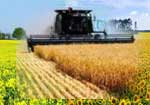
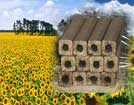
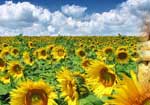



2. Pellets 8mm
3. 6-8 mm DIN+ Quality Pellets
4. We manufacture and sell fuel pellets from straw to European countries
5. Sell wood pellets
6. Wood pellet manufacturing
7. Sunflower Husk Pellets
8. Din Plus Wood Pellets
9. Export of sunflower husk pellets to the European market
10. Export of sunflower husk pellets to the European market
Charcoal production methods
Thu-26-2015Methods of charcoal production
Charcoal is a prime source of energy which is made from organic matter in the absence of air at temperatures above 300°C. There are various methods of charcoal production. Some of these methods are crude and have low yield and quality of the charcoal produced while others are highly automated.
There are three most common charcoal production methods today: earth kilns, brick and metal kilns. The most common earth kilns are the traditional and improved earth kilns. The brick kilns are represented by the Argentine half orange Kiln and the Brazilian beehive kiln and the metal kilns by the drum kiln.

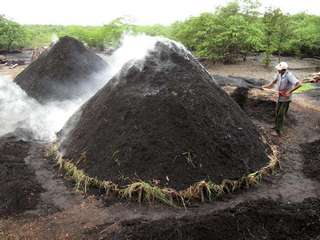
Earth kilns as the simplest method for charcoal production
Earth pit kilns represent the simplest technology for charcoal production. It is the traditional way of making charcoal in many parts of the world. The process of using earth pit kilns begins by stacking wood in a pit, then sealing it with a layer of grass and soil and igniting the wood at one end, starting carbonization. Earth kilns are usually large and they can use large pieces of wood, but they can also have small size and be suitable for households. However, the ventilation system of this type of kilns has some disadvantages. It may be difficult to control and usually the carbonization is incomplete, producing only low quality charcoal.
The improved earth kilns such as the Casamance kiln and the Swedish earth kiln are equipped with a chimney. The chimney allows a better control of air flow and reduces heat loss during carbonization and improves gas circulation, giving a higher quality of charcoal and efficiency up to 30 %. The charcoal produced in the improved earth kilns has a high proportion of fixed carbon, low volatile matter and a low bulk density. However, the earth kiln must be completely rebuilt after each cycle. Its production cycle lasts 24 hours what is too long. The kiln operation requires considerable skill and experience.
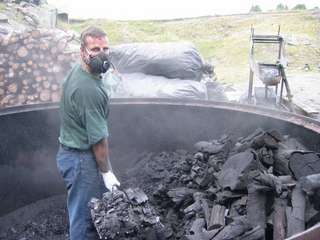
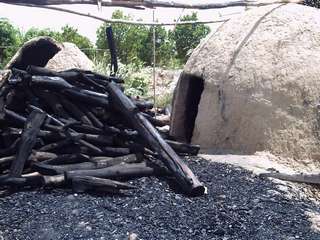
Brick kilns as an effective method of charcoal production
The brick kiln is one of the most effective methods of charcoal production, giving the efficiency of up to 30 %. It is suitable for semi-industrial production of charcoal. However, as brick kilns are stationary once built, they can only be used in areas with an easy supply of wood. The kiln could also be built using concrete instead of bricks.
There are many types of brick kilns in the world and most of them give good results. The most notable designs are the Argentine half orange kiln and the Brazilian beehive kiln. The first Kiln is made entirely from brick and mud. The carbonisation cycle is much quicker and lasts 13 – 14 days. It is important to know that easy drainage of water away from the kiln is the main requirement of setting the kiln. The Brazilian beehive kiln is internally heated, fixed, batch type. They are circular, have a domed roof and are made of ordinary bricks. The circular wall of the kiln is in contact with the outside air. The carbonization cycle lasts 9 days with a production of 5t/cycle. It has a high efficiency of up to 62% when properly operated. The life span of the kiln is up to 6 years on the same site.
Modern methods of charcoal production
Steel kilns are considered as one basis of modern charcoal production. Many different types of steel kilns have been developed throughout the world. The main difference of steel kilns is in their capability to carbonize even poor quality wood. What is more, it can easily be transported. However, still kilns are not suitable for high-volume production as their annual output is only about 100 – 150 t of charcoal, wherein their efficiency is high (27 – 35 %) and the process of carbonization is quick (from 16 to 24 hours).
Steel drum kilns facilitate access to sustianably made charcoal as the kilns are low cost, portable and easy to use. Moreover, the conversion efficiency obtained in oil drum kilns is around 23%. However, the main disadvantage of the kiln is that the raw material must be less than 30 cm long and the diameter must be 5 cm, what requires a considerable amount of labour in the preparation of the raw material.
So, there are three main methods of charcoal production which are represented by many types of kilns used throughout the world. The earliest method of charcoal production based on using earth pit kilns. It is still a very popular technology, but the earth kiln operation requires considerable knowledge and experience, as well it must be completely rebuilt after each cycle. Today the most popular methods include steel and brick kilns as they are easy to use, could carbonize even poor quality wood, give high quality charcoal. However, the carbonisation cycle of steel kilns is much quicker than others and lasts 16-24 hours, wherein it is highly automated.
Source: http://ukrfuel.com/news-charcoal-production-methods-24.html
Any copying and distributing withoutactive hyperlink is strictly prohibited!
Views: 6237
 Stobart biomass division is to make a deal
Stobart biomass division is to make a deal
Biomass Related News
- Australia transits to solar power generation
- Nikopol Enterprise Turbostal switches to the use of wood pellets
- Solar panel new technologies bring high efficiency
- Solar power battery charging becomes reality
- Energy plays great role in determining performance
- New South Wales sets solar energy world record
- How to make wood charcoal
- New world record for solar cell efficiency
- Refining Biomass in the Slovak Republic
- Refining biomass in Italy
|
© Ukrainian Biofuel Suppliers 2008-2024 |
